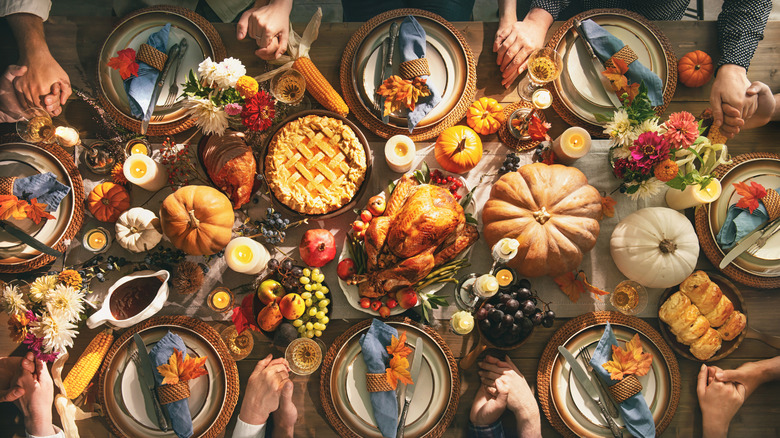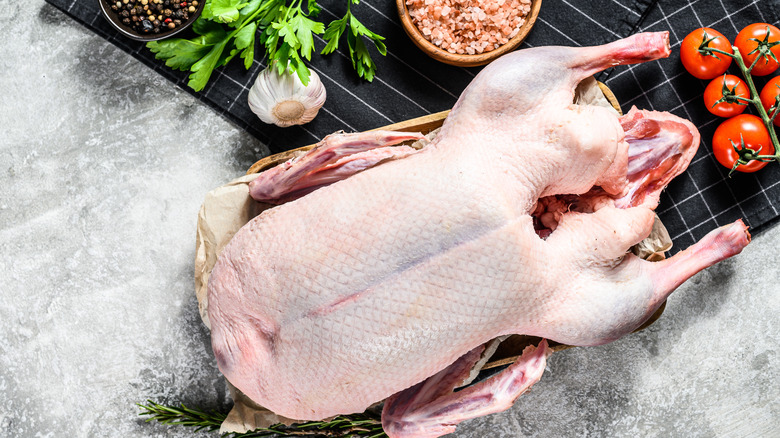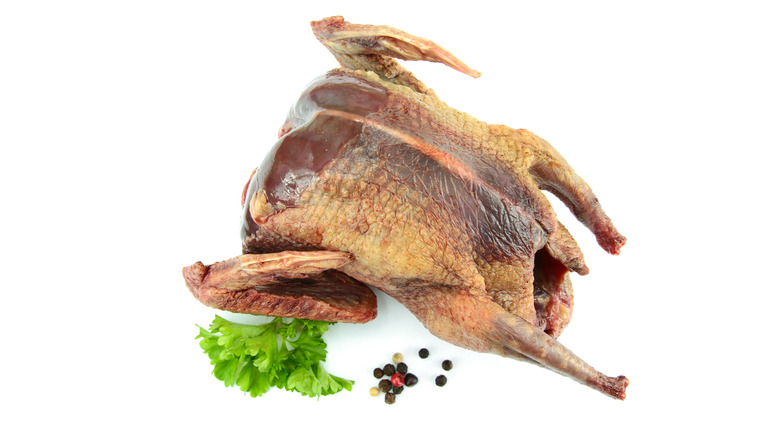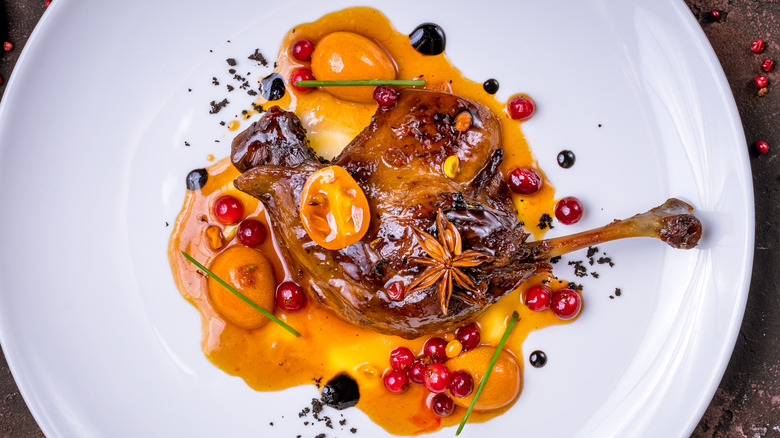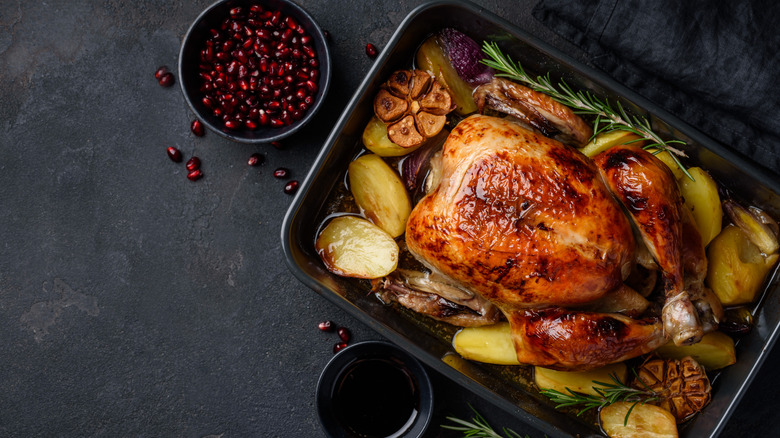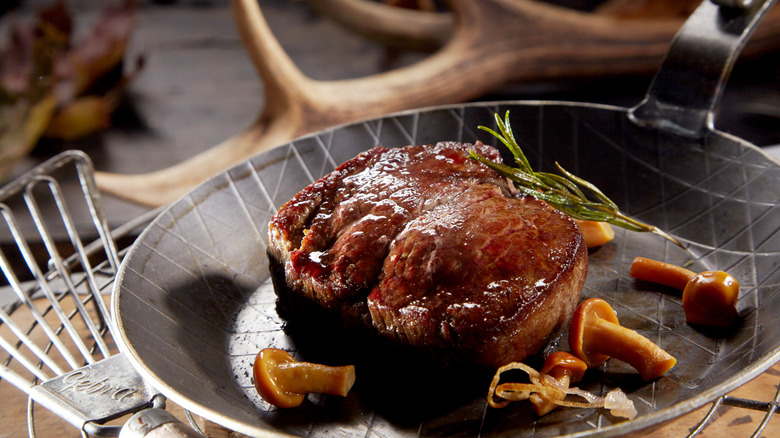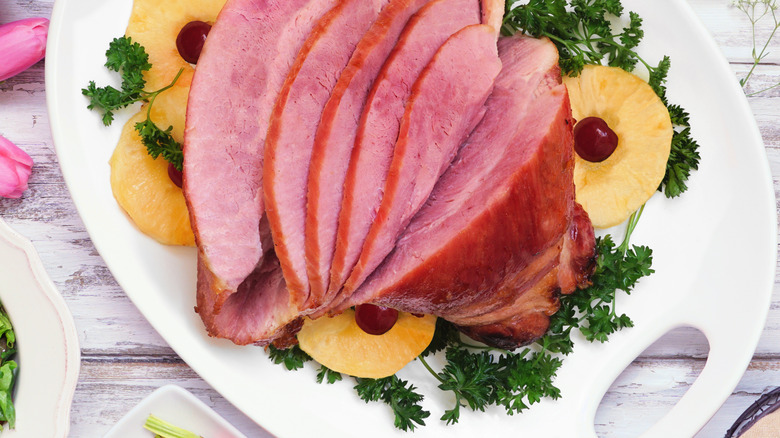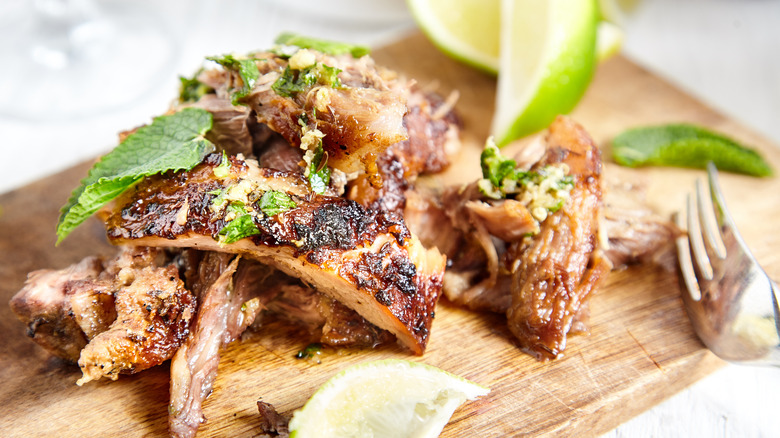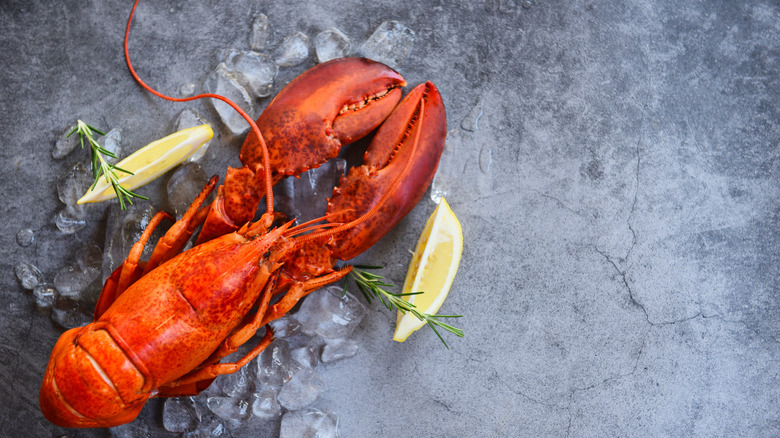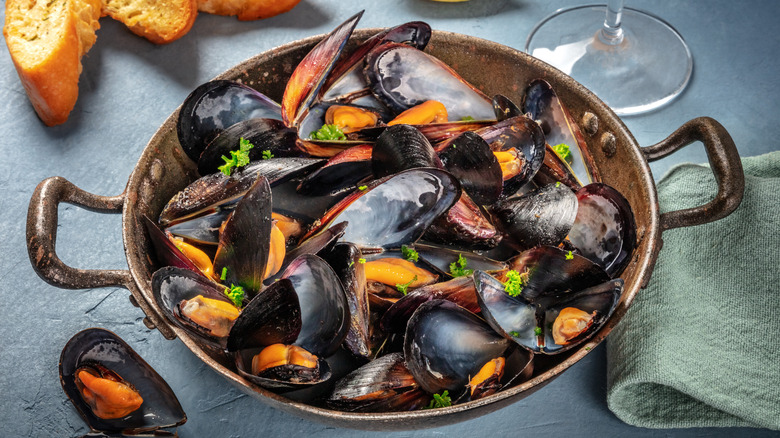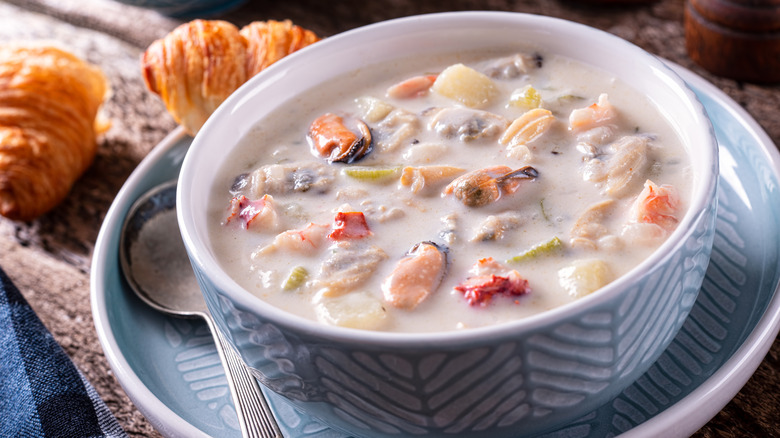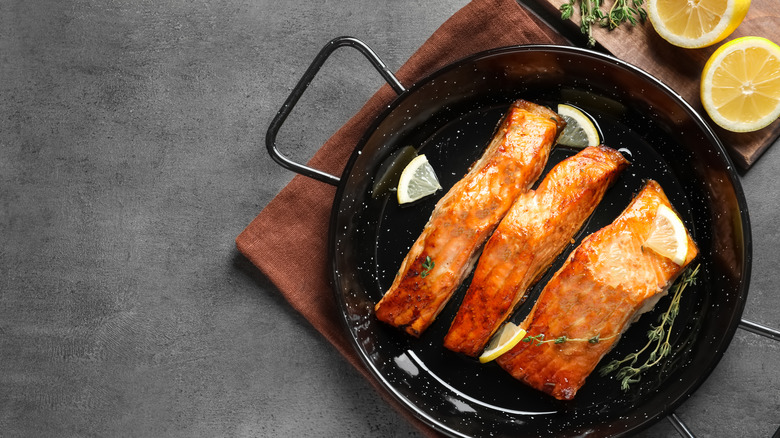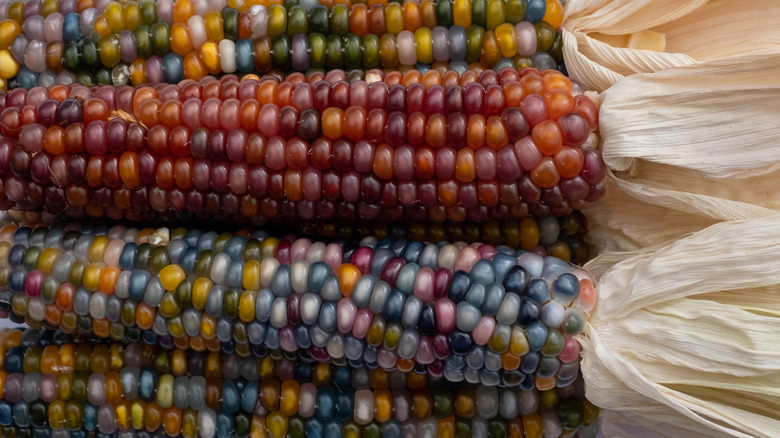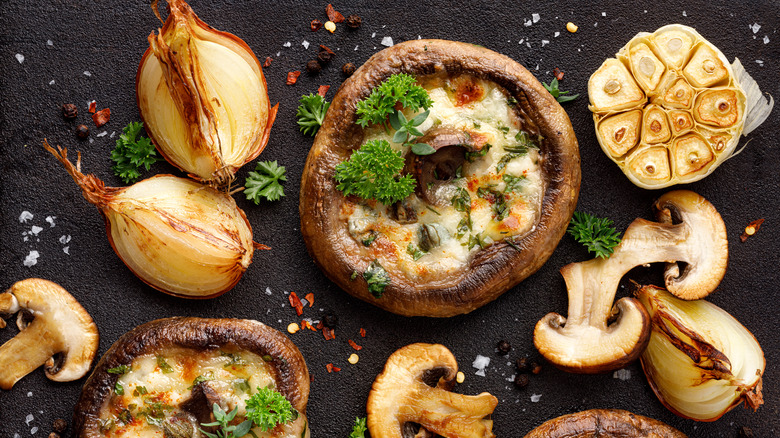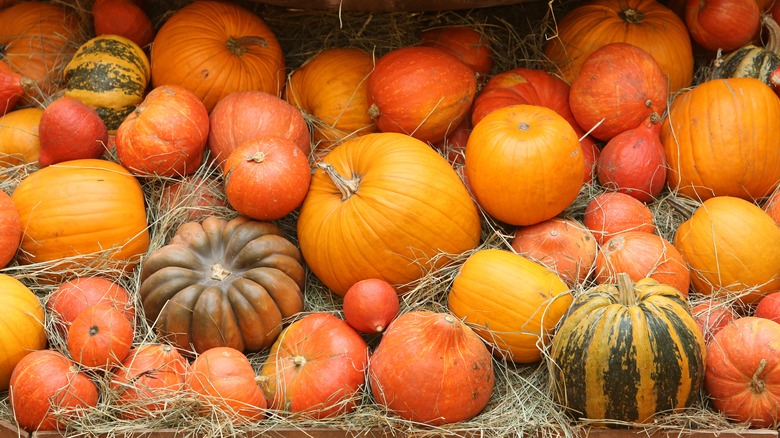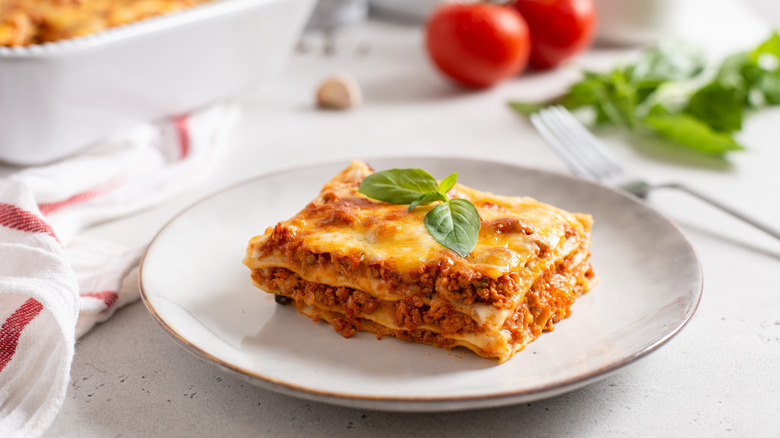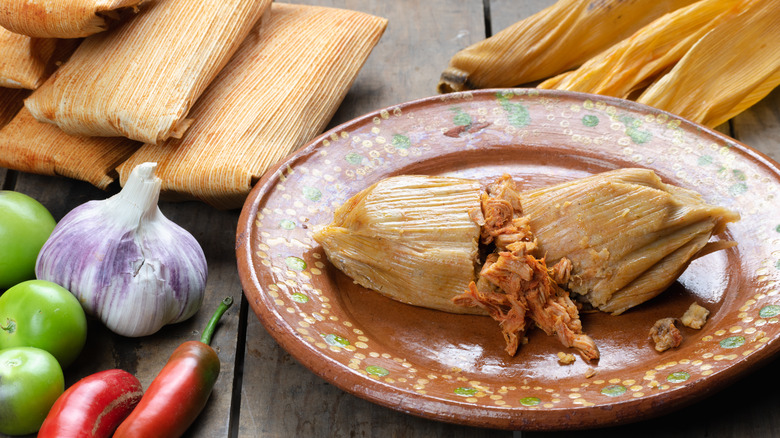16 Foods You Can Serve This Thanksgiving Instead Of Turkey
When you think of Thanksgiving, you're likely imagining sides like mashed potatoes and green bean casserole surrounding a turkey centerpiece. But Thanksgiving doesn't begin and end with this stereotypical meal! In fact, the very first Thanksgiving likely featured oysters and venison rather than green beans — and what's more, Americans across the country deck their table with a veritable panoply of choices today.
According to the Smithsonian, we can be fairly sure that there was wildfowl — including wild turkey – at the harvest celebration shared between the Pilgrims and the Wampanoag in 1621. The Thanksgiving menu as we know it today really took form when President Abraham Lincoln first established Thanksgiving as a national holiday in 1863, after the repeated petitions of Sarah Josepha Hale, editor of women's magazine Godey's Lady's Book. Hale's proposed menu featured modern Thanksgiving mainstays like sage dressing, creamed onions, and mashed potatoes.
Today, a host of different communities all over the U.S. celebrate with their own traditions ranging from lasagna to tamales to mojo pork. Seeing as national supply chain issues will likely be leading to turkey shortages around the country, now is the perfect time to deviate from the norm.
Whether you want your Thanksgiving to hearken back to the very first harvest celebration or break from tradition entirely, here are a few choices to consider in place of turkey.
1. Goose
Roast goose might seem far more Dickensian than colonial, but according to Kathleen Wall, a foodways culinarian at Plimoth Plantation in Plymouth, Massachusetts, while turkey was certainly plentiful in the New World, it's far more likely that the first Thanksgiving featured a different kind of wildfowl: goose (via Smithsonian).
Goose can be quite fatty, which makes some home cooks balk. And according to NPR, while goose was once common on American tables, it has fallen out of fashion largely due to its pronounced flavor and to the fact that it's all dark meat. But trust us: not only is goose meat delicious, goose fat is one of the tastiest cooking fats around. A special occasion like Thanksgiving is the perfect time to make this imposing centerpiece.
Be sure to siphon off the goose fat as it roasts. It makes the perfect base for delicious roast potatoes as a side dish, killing two, uh, birds with one stone.
2. Pigeon
According to Kathleen Wall, passenger pigeons definitely would have been available to those at the first Thanksgiving festivities."Passenger pigeons—extinct in the wild for over a century now—were so thick in the 1620s, they said you could hear them a quarter-hour before you saw them," she tells the Smithsonian. "They say a man could shoot at the birds in flight and bring down 200."
Pigeon might not sound super appetizing, but if you've ever had squab, guess what? You've had it before. A squab, according to the USDA, is just a small pigeon, and since pigeon is already a far smaller bird than turkey, goose, or even chicken, it's kind of perfect if you're keeping your Thanksgiving celebrations smaller this year. Darker in color and richer in flavor than turkey or chicken, squab is known for being super tender and flavorful. It goes wonderfully well with another Thanksgiving staple: cranberry sauce!
3. Duck
As opposed to the turkey that features so heavily on most Americans' Thanksgiving tables, Kathleen Wall, offers the far more historically likely alternative of duck. Easier to find (and perhaps more palatable) than other historically accurate suggestions like roast swan, duck is a delicious, richly flavored meat that's particularly happy when cooked low and slow, making it the perfect centerpiece for a holiday where timing is everything (via The New York Times). Unlike turkey, if your duck hangs out in the oven for an extra five minutes, it's unlikely to become dry as sawdust!
As a counterpoint, however, duck can tend towards greasiness. Be sure to take the proper precautions when preparing this bird for your Thanksgiving table, and trust experts to be your guides in crafting the perfect roast duck.
This bird's rich flavor makes it the perfect pair for sweeter autumnal produce like pomegranates, sweet potatoes, pumpkin, or cranberries.
4. Chicken
If roast turkey feels too big, too dry, or just too tough to find with this year's turkey shortages on the horizon, go for the next best thing: roast chicken. Epicurious makes a solid case for swapping out the bird, noting that a roast chicken is far more delicious (and far less of a faff) than a giant turkey, most of which will be relegated to leftovers purgatory anyway. And the best part of turkey — the stuffing — is just as happy in a chicken cavity.
Of course, if you want to go the traditional route, stuffing is far from the ideal recourse. Bread stuffing the likes of which we enjoy on modern Thanksgiving tables is unlikely to have featured at the first Thanksgiving, according to Kathleen Wall, due to a lack of wheat. She tells the Smithsonian, however, that the Pilgrims did indeed stuff birds with other things, including onion chunks, herbs, and even shelled chestnuts. While we're very glad to have bread stuffings on our modern Thanksgiving tables, there's no harm in tossing a few chestnuts into the mix in a nod to tradition!
5. Venison
Since the Pilgrims did not Instagram their first Thanksgiving meal, much of what culinary historians have deduced about what really featured on that 17th century table comes down to educated guesses stemming from general knowledge about what colonists and the Wampanoag ate around this time. But we do have one primary source about the meal — a letter written in 1621 by colonist and Thanksgiving guest Edward Winslow. In his description of the first feast, he writes that the Wampanoag went out "and killed five deer, which they brought to the plantation and bestowed on our governor, and upon the captain and others" (via Vital Choice) So we can be fairly sure that venison featured on the table, making it a delightful lean and meaty alternative to poultry on your Thanksgiving table!
Leaner and slightly gamier than beef, venison is rich in B vitamins and low in fat. Serve it with seasonal mushrooms for a delicious alternative to turkey.
6. Ham
Baked ham is more of an Easter mainstay, but there's no real reason why you can't snag a spiral-cut ham for Thanksgiving instead! Delicious and richly flavored, it pairs nicely with the traditional Thanksgiving sides. And unlike a turkey, a baked ham won't monopolize your oven for hours on end.
Chef and recipe developer Erin Johnson of Probably in the Kitchen told Mashed, "Ham is already cooked when you purchase it, you're just reheating it." Fifteen minutes per pound is all you need for a succulent, delightful baked ham ready to serve to a crowd. Bone-in ham offers a greater visual spectacle as a centerpiece, not to mention a more tender finished product. Opt for a simple glaze like mustard in order to avoid overwhelming the side dishes.
A baked ham is big, but leftover baked ham is a delight. Serve it on sandwiches; dice it and toss it into pasta or a salad. The possibilities are endless!
7. Mojo pork
America is a melting pot of different cultures and cuisines, each of which adds their own spins to the Thanksgiving tradition. In Cuban families, for example, mojo pork is a mainstay of Thanksgiving tables. Marinated in a citrusy blend of orange, lime, mint, garlic, oregano, and spices, this pork is often served in addition to turkey, though the ultra-flavorful pork definitely rivals the bird as the centerpiece
"My American family places more emphasis on salads and the turkey," Coral Gables high school student Audrey Weigel tells her school paper, "while my Cuban family does have both but the main emphasis is on Cuban bread and having a wide choice of other meats available."
Whether you choose to serve mojo pork in addition to turkey or instead of it, be sure to make a lot: Any leftover mojo pork is the perfect filling for classic Cuban sandwiches come Black Friday.
8. Lobster
According to Food & Wine, most of what we know about the Thanksgiving meal comes from a 1621 letter penned by colonist Edward Winslow, a guest of the feast. In the letter, Winslow describes a bay teeming with eels, mussels, and lobster, and the latter is a particularly delicious centerpiece for the Thanksgiving table.
It's no surprise that lobster was plentiful in colonial Plymouth. Lobster was once so abundant in the American colonies that it was given to prisoners and the poor as a cheap source of meat and were once even dubbed the "cockroaches of the sea" (via Gizmodo) Today, however, lobster is far more expensive — but given the special occasion status of Thanksgiving, it's the ideal time to shell out (hehe) on this New England staple.
Cooking lobster at home might seem like a feat, but in reality, it's fairly simple — and far quicker than turkey. Grilled lobster is a simple, phenomenal choice when served with drawn butter (and it liberates the oven so you can double down on cornbread and sweet potato casserole). Lobster can also dress up other staple side dishes like this decadent lobster mac and cheese.
9. Mussels
In addition to plentiful lobster (and, uh, eels ... ), colonist Edward Winslow also made mention of mussels in the 1621 letter that has become our most prominent primary source regarding what was actually served at the first Thanksgiving meal shared between the colonists and the Wampanoag. Indeed, at the living museum in Plymouth, the New England Harvest Feast regularly includes "Mussels Seeth'd with Parsley and Beer," which is basically an American answer to mussels marinière (via Vital Choice). Steamed in this way, mussels release their delicious briny juices, perfect for sopping up with fresh bread (or drizzling over your mashed potatoes in place of gravy!)
Mussels also make a beautiful centerpiece to your Thanksgiving table, particularly when prepared and served in an enamelware Dutch oven like a Le Creuset. Just be sure to clean your mussels properly before cooking so that guests don't have to contend with sand, grit, or beards. Any leftovers can be stored and reheated carefully, served, for example, with pasta or atop risotto.
10. Clams
Seafood was plentiful in Plymouth when the first Thanksgiving was celebrated between the colonists and the Wampanoag, and so it's likely that in addition to lobster, eels, and mussels, clams were served — very likely in chowder form. Indeed, the soup now known as New England clam chowder predates the arrival of English colonists. Locals have been making Quahog chowder with local quahog clams for four centuries, according to Indian Country Today, combing the shellfish with local corn and beans. (Potatoes were only added later, but as a New World food, they're certainly a welcome addition!)
At Thanksgiving, clam chowder makes a nice first course option if you decide to serve a plated meal. A big tureen of clam chowder can also stand in as a turkey centerpiece, precluding the need for meat entirely. Whether you choose the creamy New England version or the tomato-based Manhattan iteration is entirely up to you.
11. Salmon
If you're looking for a turkey stand-in that's just as impressive, roast salmon is a lovely choice. A hefty fish that stands up well to bold flavors, salmon can pair well with the sage-scented stuffing, mac and cheese, and cornbread that feature so heavily on the Thanksgiving side dish rotation. And what's more, salmon is positively delicious when glazed in Native American ingredients like maple syrup or cranberry sauce.
Choose wild salmon whenever possible: not only is it more delicious than farmed, it actually boasts a superior nutritional profile, and it's a more environmentally sustainable choice to boot.
If you're serving a crowd, consider ordering a whole salmon fillet from your fishmonger and roasting it whole on a sheet pan. Garnished with lemon wedges, whole cranberries, or orange slices, it will make just as beautiful a centerpiece as a burnished roast bird. (And it'll be ready in a fraction of the time!)
12. Flint corn
Flint corn, aka multicolored Indian corn, was a staple of the Wampanoag diet, according to Plimoth Plantation's Kathleen Wall (via Smithsonian). Food52 reports that this brightly colored corn was likely eaten as a porridge or as cornbread. Indeed, this corn, which is named for its texture (aka as hard as flint) would likely take a tooth out if you tried to enjoy it fresh off the cob like sweet corn.
On the cob, flint corn is a beautiful decoration for your Thanksgiving table, but you could also consider serving it in porridge form as a side or dessert. A porridge called nasaump made with a combination of dried corn, berries, and nuts is traditional in Wampanoag communities. It can also be sweetened with maple syrup. Flint corn flour can also be used to make cornbread, polenta, and more. It boasts a more assertive "corny" taste and beautiful flecks of color sure to make any dish pop (via Plimoth Plantation).
13. Stuffed portobello mushrooms
If you're looking for an alternative Thanksgiving main perfect for your vegetarian guests, why not stuff some portabello mushrooms? These giant mushroom caps are a tasty vessel for your favorite vegetarian stuffing recipe, but they can also be garnished with cheese, crab (okay, not so vegetarian ... ), or even wild rice, which may well be the most American choice of fillings.
Saveur reports that despite its name, wild rice actually isn't related to white, brown, or red rice at all. A species of wild grass native to North America, wild rice has a rich, nutty flavor and a toothsome texture that stands up beautifully in dressings and stuffings. And since it hails from America – specifically from the Ojibwe Nation — it's a welcome guest at this most American celebration of harvest time. (It also pairs nicely with turkey, so any leftovers can be stirred into a hearty Thanksgiving leftovers soup.)
14. Pumpkin
Pumpkin is a mainstay of the Thanksgiving table today, and according to Kathleen Wall, it's a historically accurate choice.
"The English colonists plant gardens in March of 1620 and 1621," she tells the Smithsonian. "We don't know exactly what's in those gardens. But in later sources, they talk about turnips, carrots, onions, garlic and pumpkins as the sorts of things that they were growing."
We're not entirely sure if and how pumpkins featured on the Thanksgiving table, but according to Food52, they may well have been stewed with vinegar and currants. However they appeared, one thing's for sure: it wasn't in a pie.
"The pastry isn't there," Wall tells the Smithsonian: The colonists had neither the butter nor the wheat flour they would have needed to make the dough for such a dish, be it sweet or savory.
Stuffed kabocha squash, however, makes a delightful vegetarian main dish, with its rich, creamy texture and bright orange hue that pairs just as well with wild rice as with lentils. It's an imposing centerpiece if you're foregoing turkey. Squash galette, meanwhile, with its pastry base, may not be as historically accurate, but it's certainly delicious.
15. Lasagna
If you're foregoing turkey (or you just want another option on the table!) why not take a page out of the books of Italian-American families and serve lasagna instead? According to Food & Wine, this baked pasta dish makes just as imposing a centerpiece. And did you know that in terms of tradition, it actually predates the mac and cheese so common on Southern Thanksgiving tables?
Baked macaroni first began featuring on Thanksgiving tables in the 1880s, but according to historians, these first versions would have included tomato and been more similar to lasagna than mac and cheese. Round out the tradition by choosing a spaghetti squash and turkey lasagna recipe for even more Thanksgiving flair.
Perhaps best of all? Most lasagna recipes only get better with time, so you can prep this bad boy in advance or choose an easy lasagna recipe to make the day of that won't be nearly as stressful as a big bird.
16. Tamales
In Texas and other parts of the Southwest, according to Forbes, tamales appear frequently on Thanksgiving tables, particularly in Latino families. The dish, which is made of a masa dough wrapped in a corn husk and steamed, can either feature a traditional filling such as ancho chile-infused pork or a slightly atypical but wholly Thanksgiving-themed slant. Fillings like turkey and cranberry sauce or pumpkin and spices would certainly make this dish a fun play on Thanksgiving tradition!
While some folks make their Thanksgiving tamales from scratch at home, tamales are a bit labor-intensive, which means that others prefer to outsource, especially if they've already got their hands full with the rest of the feast. Luckily, there are a plethora of companies that prepare and sell Thanksgiving tamales, so ordering from one of these specialists is another great way to get this festive main on your holiday table (via The Southern Weekend).
